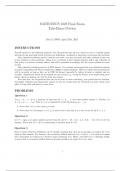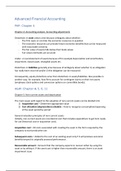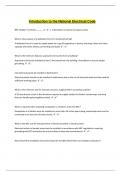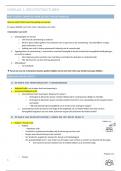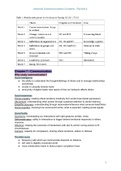Chapter 1 ................................................................................................................................................ 3
Types of data and measurement ........................................................................................................ 3
Frequency distributions...................................................................................................................... 3
Measures of central tendency ............................................................................................................ 5
Measures of variability ....................................................................................................................... 5
Chapter 2 ................................................................................................................................................ 7
Correlation.......................................................................................................................................... 7
Chapter 3 ................................................................................................................................................ 7
Randomness ....................................................................................................................................... 7
Relationships between events ........................................................................................................... 7
Probability .......................................................................................................................................... 8
Chapter 4 ................................................................................................................................................ 9
Probability models.............................................................................................................................. 9
Random variables ............................................................................................................................... 9
Common distribution ....................................................................................................................... 10
Chapter 5 .............................................................................................................................................. 12
Sampling and sampling methods ..................................................................................................... 12
Sampling distributions ...................................................................................................................... 12
Chapter 6 .............................................................................................................................................. 13
Parameter estimation and confidence intervals .............................................................................. 13
Confidence interval for the population mean .............................................................................. 14
Confidence interval for the population proportion ..................................................................... 14
Chapter 7 .............................................................................................................................................. 15
Introduction to hypothesis testing (p-value approach) .................................................................... 15
Hypothesis test for a population proportion.................................................................................... 18
One-sample t-test............................................................................................................................. 19
Chapter 8 .............................................................................................................................................. 20
Paired samples t-test ........................................................................................................................ 20
Independent samples t-test ............................................................................................................. 21
Independent proportions z-test ....................................................................................................... 22
Chapter 9 .............................................................................................................................................. 23
Simple linear regression ................................................................................................................... 23
Multiple linear regression ................................................................................................................ 24
Chapter 9.1 ........................................................................................................................................... 25
Simple linear regression ................................................................................................................... 25
Chapter 11 ............................................................................................................................................ 26
Chi-square goodness of fit test......................................................................................................... 26
Chi-square test for independence .................................................................................................... 27
,Chapter 11 ............................................................................................................................................ 28
One-way analysis of variance ........................................................................................................... 28
2
, Chapter 1
Types of data and measurement
• A qualitative variable is non-numerical or categorical in nature, meaning names or labels are
used to classify observations into different categories.
• A quantitative variable is numerical in nature and is measured through acts of counting or
with the use of measurement instruments.
• A discrete variable can either take on a finite number of values or can take on infinitely many
values that can be labeled with numbers (e.g., 0,1,2,3…)
• A continuous variable can take on any value in one or more intervals.
The complete set of categories or values that are used to differentiate between observations is called
the scale of measurement. There are a total of four different scales to consider:
Nominal and ordinal scales are qualitative scales, interval and ratio are quantitative scales.
Direction Direction of the Size of the Calculate ratios
differences (=, ≠) difference (>, <) difference (+, -) (×,÷)
Nominal Yes No No No
Ordinal Yes Yes No No
Interval Yes Yes Yes No
Ratio Yes Yes Yes Yes
Frequency distributions
• A frequency distribution organizes a sample by ordering the observations from lowest to
highest score and grouping together all observations with the same score. There are three
important properties:
- Centrality refers to what a typical or average score looks like.
- Variability relates to whether the scores are clustered together or spread out evenly.
- The shape of the distribution is related to the degree to which a distribution is either
symmetrical or skewed.
• The absolute frequency of a score is the number of times that particular score occurs in the
dataset and is denoted by lowercase 𝑓.
• The relative frequency of a score is the absolute frequency of that score divided by the total
(
number of scores in the dataset and is denoted 𝑓!"#$%&'" . ( 𝑓!"#$%&'" = ) )
• To transform a relative frequency into a percent frequency, multiply the relative frequency
by 100%. Percent frequencies are denoted %𝑓.
• The cumulative frequency of a score is the number of scores that have a value at or
below the score in question and is denoted 𝑐𝑓.
• The cumulative relative frequency is the proportion of scores that have a value less than or
*(
equal to the score in question and is denoted 𝑐𝑓!"#$%&'" . ( 𝑐𝑓!"#$%&'" = ) )
• The cumulative percent frequency is the percentage of scores that have a value less than or
equal to the score in question and is denoted 𝑐%. ( 𝑐% = 𝑐𝑓!"#$%&'" • 100% )
A bar chart is used to display the frequencies of qualitative data.
A histogram is used to display the frequencies of quantitative data.
The graph of a cumulative frequency distribution is called an ogive.
3
Types of data and measurement ........................................................................................................ 3
Frequency distributions...................................................................................................................... 3
Measures of central tendency ............................................................................................................ 5
Measures of variability ....................................................................................................................... 5
Chapter 2 ................................................................................................................................................ 7
Correlation.......................................................................................................................................... 7
Chapter 3 ................................................................................................................................................ 7
Randomness ....................................................................................................................................... 7
Relationships between events ........................................................................................................... 7
Probability .......................................................................................................................................... 8
Chapter 4 ................................................................................................................................................ 9
Probability models.............................................................................................................................. 9
Random variables ............................................................................................................................... 9
Common distribution ....................................................................................................................... 10
Chapter 5 .............................................................................................................................................. 12
Sampling and sampling methods ..................................................................................................... 12
Sampling distributions ...................................................................................................................... 12
Chapter 6 .............................................................................................................................................. 13
Parameter estimation and confidence intervals .............................................................................. 13
Confidence interval for the population mean .............................................................................. 14
Confidence interval for the population proportion ..................................................................... 14
Chapter 7 .............................................................................................................................................. 15
Introduction to hypothesis testing (p-value approach) .................................................................... 15
Hypothesis test for a population proportion.................................................................................... 18
One-sample t-test............................................................................................................................. 19
Chapter 8 .............................................................................................................................................. 20
Paired samples t-test ........................................................................................................................ 20
Independent samples t-test ............................................................................................................. 21
Independent proportions z-test ....................................................................................................... 22
Chapter 9 .............................................................................................................................................. 23
Simple linear regression ................................................................................................................... 23
Multiple linear regression ................................................................................................................ 24
Chapter 9.1 ........................................................................................................................................... 25
Simple linear regression ................................................................................................................... 25
Chapter 11 ............................................................................................................................................ 26
Chi-square goodness of fit test......................................................................................................... 26
Chi-square test for independence .................................................................................................... 27
,Chapter 11 ............................................................................................................................................ 28
One-way analysis of variance ........................................................................................................... 28
2
, Chapter 1
Types of data and measurement
• A qualitative variable is non-numerical or categorical in nature, meaning names or labels are
used to classify observations into different categories.
• A quantitative variable is numerical in nature and is measured through acts of counting or
with the use of measurement instruments.
• A discrete variable can either take on a finite number of values or can take on infinitely many
values that can be labeled with numbers (e.g., 0,1,2,3…)
• A continuous variable can take on any value in one or more intervals.
The complete set of categories or values that are used to differentiate between observations is called
the scale of measurement. There are a total of four different scales to consider:
Nominal and ordinal scales are qualitative scales, interval and ratio are quantitative scales.
Direction Direction of the Size of the Calculate ratios
differences (=, ≠) difference (>, <) difference (+, -) (×,÷)
Nominal Yes No No No
Ordinal Yes Yes No No
Interval Yes Yes Yes No
Ratio Yes Yes Yes Yes
Frequency distributions
• A frequency distribution organizes a sample by ordering the observations from lowest to
highest score and grouping together all observations with the same score. There are three
important properties:
- Centrality refers to what a typical or average score looks like.
- Variability relates to whether the scores are clustered together or spread out evenly.
- The shape of the distribution is related to the degree to which a distribution is either
symmetrical or skewed.
• The absolute frequency of a score is the number of times that particular score occurs in the
dataset and is denoted by lowercase 𝑓.
• The relative frequency of a score is the absolute frequency of that score divided by the total
(
number of scores in the dataset and is denoted 𝑓!"#$%&'" . ( 𝑓!"#$%&'" = ) )
• To transform a relative frequency into a percent frequency, multiply the relative frequency
by 100%. Percent frequencies are denoted %𝑓.
• The cumulative frequency of a score is the number of scores that have a value at or
below the score in question and is denoted 𝑐𝑓.
• The cumulative relative frequency is the proportion of scores that have a value less than or
*(
equal to the score in question and is denoted 𝑐𝑓!"#$%&'" . ( 𝑐𝑓!"#$%&'" = ) )
• The cumulative percent frequency is the percentage of scores that have a value less than or
equal to the score in question and is denoted 𝑐%. ( 𝑐% = 𝑐𝑓!"#$%&'" • 100% )
A bar chart is used to display the frequencies of qualitative data.
A histogram is used to display the frequencies of quantitative data.
The graph of a cumulative frequency distribution is called an ogive.
3


